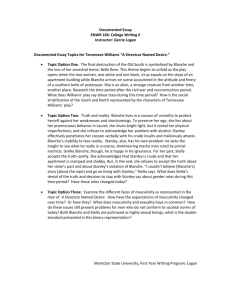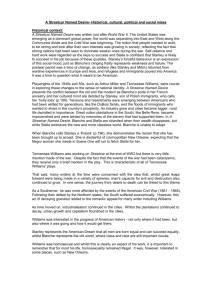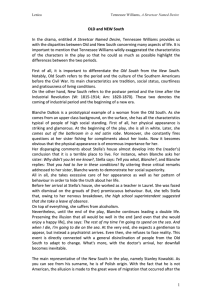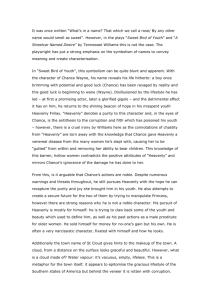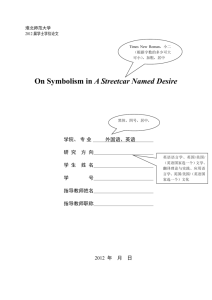On Symbolism in A Streetcar Named Desire
advertisement
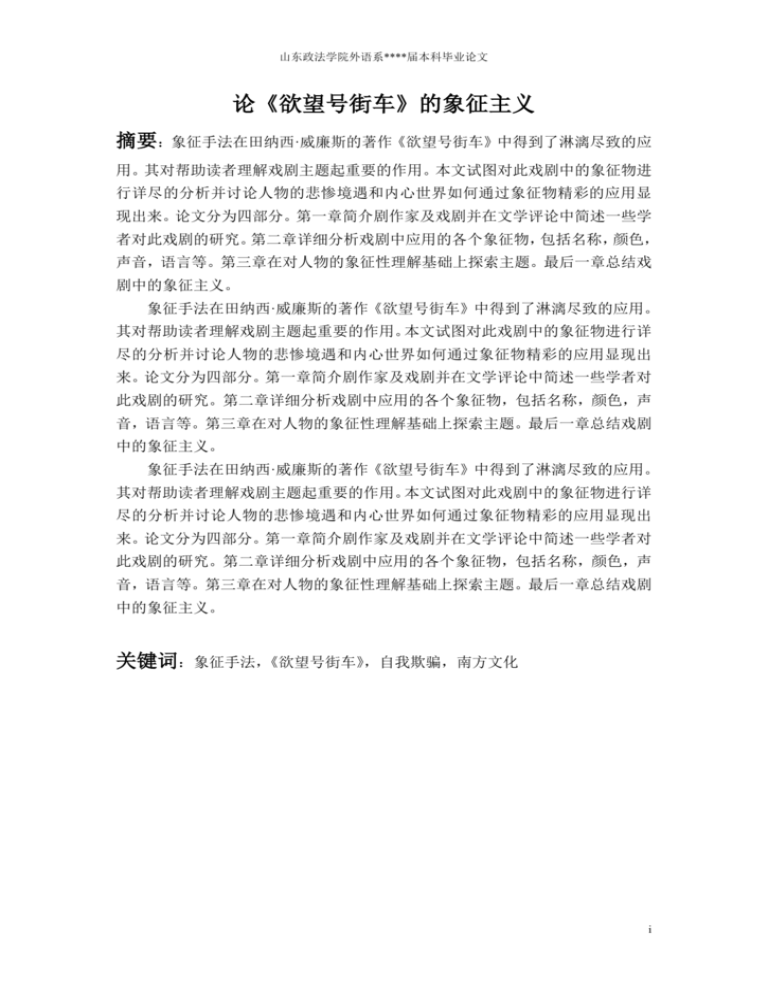
山东政法学院外语系****届本科毕业论文 论《欲望号街车》的象征主义 摘要:象征手法在田纳西·威廉斯的著作《欲望号街车》中得到了淋漓尽致的应 用。其对帮助读者理解戏剧主题起重要的作用。本文试图对此戏剧中的象征物进 行详尽的分析并讨论人物的悲惨境遇和内心世界如何通过象征物精彩的应用显 现出来。论文分为四部分。第一章简介剧作家及戏剧并在文学评论中简述一些学 者对此戏剧的研究。第二章详细分析戏剧中应用的各个象征物,包括名称,颜色, 声音,语言等。第三章在对人物的象征性理解基础上探索主题。最后一章总结戏 剧中的象征主义。 象征手法在田纳西·威廉斯的著作《欲望号街车》中得到了淋漓尽致的应用。 其对帮助读者理解戏剧主题起重要的作用。本文试图对此戏剧中的象征物进行详 尽的分析并讨论人物的悲惨境遇和内心世界如何通过象征物精彩的应用显现出 来。论文分为四部分。第一章简介剧作家及戏剧并在文学评论中简述一些学者对 此戏剧的研究。第二章详细分析戏剧中应用的各个象征物,包括名称,颜色,声 音,语言等。第三章在对人物的象征性理解基础上探索主题。最后一章总结戏剧 中的象征主义。 象征手法在田纳西·威廉斯的著作《欲望号街车》中得到了淋漓尽致的应用。 其对帮助读者理解戏剧主题起重要的作用。本文试图对此戏剧中的象征物进行详 尽的分析并讨论人物的悲惨境遇和内心世界如何通过象征物精彩的应用显现出 来。论文分为四部分。第一章简介剧作家及戏剧并在文学评论中简述一些学者对 此戏剧的研究。第二章详细分析戏剧中应用的各个象征物,包括名称,颜色,声 音,语言等。第三章在对人物的象征性理解基础上探索主题。最后一章总结戏剧 中的象征主义。 关键词:象征手法,《欲望号街车》,自我欺骗,南方文化 i On Symbolism in A Streetcar Named Desire Abstract: Symbolism is profoundly used in Tennessee Williams’ masterpiece, A Streetcar Named Desire and plays an important role in the play by helping readers understand the concept of the theme. Since its publication in 1945, this play has become an American classic and a world renowned one. It is widely studied home and broad. There are many interesting ways to look at the play. This paper is an attempt to give a comprehensive analysis of specific symbols in this play and to discuss how the misery and the inner world of the characters are disclosed through the remarkable use of symbols. Symbols are profuse in the play and they help to achieve a thematic importance when combined with the romantic realism that Williams favored at the beginning of his career. Stanley, the son of a polish immigrant, represents the changing face of America. Stanley is able to accept and is part of this change, which is a contrast to Blanche’s stubborn inability to change. Stanley is the new America to which the aristocratic Blanche does not belong because she is a relic from the dying Old South. Blanche and her sister come from a dying world. The life and pretensions of their world are becoming memory: Blanche is stuck win the past and she clings dearly to her old possessions which is reflected in her possessiveness of her letters. Stanley with his Polish ancestry is clearly represented by the changing of times and the ability to adapt to new cultures of New Orleans. In the New South, animal instinct and common sense win out over lofty ideals and romantic notions. The thesis is made up of four parts. The first chapter gives a brief introduction of the playwright and the play. Also a literature review which states some scholar’s concerns in this play is given and in the second chapter, an elaborate analysis of the individual symbols such as names, colors, sound, language and other images in life applied in this play is presented. Chapter three is a thematic probe into the play based on the symbolic understandings of the characters. Finally, a conclusion is given to summarize symbolism in this play. Key Words: Symbolism; A Streetcar Named Desire; Self-delusion; Southern culture ii 山东政法学院外语系****届本科毕业论文 Contents 摘要................................................................................................................................. i 关键词............................................................................................................................. i Abstract ..........................................................................................................................ii Key Words......................................................................................................................ii Chapter One Introduction ........................................................................................... 1 1.1The playwright and the play ................................................................................................. 1 1.2 Literature review ................................................................................................................. 1 Chapter Two Study of Individual Symbols ................................................................ 2 2.1 On names............................................................................................................................. 2 2.2 On colors ............................................................................................................................. 2 Chapter Three On Symbolic Understanding of Characters ........................................ 3 3.1 Victim of self-delusions ...................................................................................................... 3 3.2 Victim of social circumstances ............................................................................................ 4 3.2.1 Victim of the old southern culture ............................................................................ 4 3.2.2 The destruction of the Old South genteel world ....................................................... 4 Chapter Four Conclusion ........................................................................................... 6 Bibliography .................................................................................................................. 7 iii 山东政法学院外语系****届本科毕业论文 On Symbolism in A Streetcar Named Desire Chapter One Introduction 1.1The playwright and the play Tennessee Williams was one of the most important and talented playwright of all history. One of his masterpieces, A Streetcar Named Desire, which was opened on Broadway in 1947, was an immediate success, catapulting him into the mainstream idolatry as an American playwright. 1.2 Literature review By now, scholars have paid much attention to various aspects in A Streetcar Named Desire. For example, Fang Jun and Liu Nuoya probe into the mature of the dramatic technique the poetic realism through meticulous study on the symbolic and expressionistic writing techniques and the interrelations of them in The Glass Menagerie and A Streetcar Named Desire (23-26)3. In Desire, Death and Dementia, researches have been put into analysis of the protagonist with understanding of symbolism (杨晋 36-38)5 . 1 Chapter Two Study of Individual Symbols 2.1 On names At the beginning of the play, readers are confronted with extremely obvious symbolic names of places. When Blanche arrives at her sister’s place, she says, “They told me to take a street-car named Desire, and then transfer to one called Cemeteries and ride six blocks and get off at Elysian Fields.” (Williams 471)2 Thus, it is possible he represents a cemetery for Blanche. Stanislaus is the name of a king of Poland. Clearly, Stanley is the king of his household. (Net. 1.)6 2.2 On colors When Blanche first appears, she is described as “daintily dressed in a white suit with a fluffy bodice, necklace and earrings of pearl, white gloves and hat”. (Williams 471) Blanche's white suit and gloves which are the symbol of purity shows her desire for purity and suggests that she wants to forget her sordid past, to hide her inner sins and to stay as an image of a dainty old south beauty. This is very ironic because white also is the color which is the most easily stained and destroyed. 2 山东政法学院外语系****届本科毕业论文 Chapter Three On Symbolic Understanding of Characters A Streetcar Named Desire can be described as an elegy, or poetic expression of mourning, for the Old South that died in the first part of the twentieth century. Alcoholism, depression, thwarted desire, loneliness, and insanity are all parts of this play. The character of Blanche Dubois is a vivid example of the use of symbolism throughout the play. Blanche is victim of her own self-delusions and Old South attitudes. 3.1 Victim of self-delusions Blanche arrives in New Orleans as an arrogant, fragile, and ultimately crumbling figure. Clinging desperately to her self-delusion, unable to accept the savage reality of what has happened to her, and just as unable to comprehend how her sister Stella can endure her current living condition, Blanche is slowly losing her mind. Her desperate line, “I don't want realism! I want magic!” (Williams 545)2 is a cry from the heart. She wishes to view life as one that is rose-colored and that goes along with her old-fashioned southern belle personality. The loss of her young husband Allan has caused her loneliness, sexual desire, and even certain signs of psychological instability. What Blanche does not realize is that she can not change the past through the present. Blanche's youth is gone, and she tries to give the appearance of being as youthful and innocent as she once was, but her illusion can not last. As an epigraph to the play, Williams quotes from the poem “The Broken Tower”, by Hart Crane: And so it was that I entered the broken world To trace the visionary company of love, its voice An instant in the wind (I know not whither hurled) But not for long to hold each desperate choice. The use of this poem helps to express Williams's choice of theme in A Streetcar Named Desire. After Blanche’s young husband Allan Grey dies, she has entered a “Broken world” of fear, longing, and sorrow because of her simple desire to hear “the visionary company of love, its voice”, or tender, gentle words of love and appreciation from Stella and Mitch. However, these words are only “visionary”. The loss of Allan and the desire to “trace” or recapture her love lead her to make so many desperate choices. (Londre 49) 1 3 3.2 Victim of social circumstances 3.2.1 Victim of the old southern culture Given Mitch’s statement, it seems that Blanche’s bad sexual experiences and romantic delusions have been the source of her fall. Yet Williams depicts the fallen, Southern women as Blanche who is also a victim of society’s rules. Before we see Blanche’s miserable life experiences and fall, let’s first have a look at the south land she has lost. In The Mind of the South, Cash present us a description of the land which cultivates those old southern gentlemen and ladies. The warm pleasant climate and leisure rich life there give this land certain atmosphere of romance. The plantation owners can have their own way in their land and enjoy the harvest by the slaves’ labors. Thus, a spirit of indulging and pleasure seeking is cultivated. But at the same time, Cash points out that those old southern residents, especially women, are puritans that are sternly restricted by their value of morality. The economic structure of the plantation leaves women highly dependent on men because for a long time, they are detached from working and management of the plantation. Thus they cling to men or become toys that entertain and please men. On one hand, they should act and speak appropriately and be lady-like because of the puritan doctrines they believe, on the other hand, they have to get men’s admiration and hearts in order to maintain their dependent position. Therefore, there is a mixture of Puritanism and hedonism in them.( 汪 义 群 83)4 Clearly , we can see the contradiction of desire and soul in Blanche. 3.2.2 The destruction of the Old South genteel world A Streetcar Named Desire describes the cultural and social differences and the arising problems between two different “worlds”. On the one hand is the former “world” of Blanche DuBois, a woman of the Old South and on the other hand is the “world” of Stella and Stanley Kowalski, who belong to the working class and live in the downtown immigrant neighborhood of New Orleans. The Northern and Southern cultures at that time were acting against each other, mirrored in Stanley and Blanche. The setting of New Orleans is important to the play. The city is one of powerful contrasts: old French architecture and the new rhythms of jazz; a kind of old world refinement mixed with a sign of poverty and modern life; decay and corruption with the regenerative powers of desire and creation. The city is eternally in a state of mixture, a mix of the modern world and New Orleans' confused history; in Americans’ eyes, New Orleans is also associated with desire and sexuality. From the beginning, the three main characters in this play are in a state of tension. 4 山东政法学院外语系****届本科毕业论文 Williams establishes that the apartment is small and confining, the weather is hot and oppressive, and the characters have good reasons to come into conflict. 5 Chapter Four Conclusion When the history of American theater is written for the 20th Century, Tennessee Williams is one of the most prominent names to be mentioned. He pushed the exploration of the human soul to the very limit in his work. Williams is fond of symbols and he successfully uses these varieties of symbols to help the audience to understand the play, especially in A Streetcar Named Desire. The symbolic use of images including names, colors, sound, language and other images in life in this play is the purest device Williams applies to resonate with the theme. The hidden ugliness from the past, both emotional and sexual neediness of Blanche and her fading beauty, vulnerability, and weakness are successfully revealed through the images such as light, bath, color whose symbolic functions have been specifically discussed in chapter two. The symbolic understanding of the characters comes to the conclusion that Blanche and Stanley are respectively the representations of the Old South and the New South and Blanche’s mental deterioration into madness and the triumph of Stanley are the sign of the destruction of the old south genteel world. 6 山东政法学院外语系****届本科毕业论文 Bibliography [1] Londre, Felicia Hardison. “A Streetcar Running Fifty Years.” The Cambridge Companion to Tennessee Williams. ed. Matthew C. Roudane. New York: Cambridge UP, 1997. [2] Williams, Tennessee. A Streetcar Named Desire,New York. New Directioins, 1978. [3] 方军、刘诺亚:“论田纳西.威廉斯‘诗化现实主义’的成熟——《玻璃动物 园》和《欲望号街车》中的象征主义和表现主义之比较研究”,《荆门职业技 术学院学报》,2001 年第 2 期,第 23-26 页。 [4] 汪义群:《当代美国戏剧》,上海:上海外语教育出版社,1992。 [5] 杨晋: “欲望、死亡和疯癫——试论《欲望号街车》女主角布兰奇·杜波依斯 的象征之旅”, 《井冈山师范学院学报(哲学社会科学)》,2002 年第 5 期,第 36-38 页。 [6] Net. 1. A Streetcar Named Desire http://www.sparknotes.com/lit/streetcar 7


